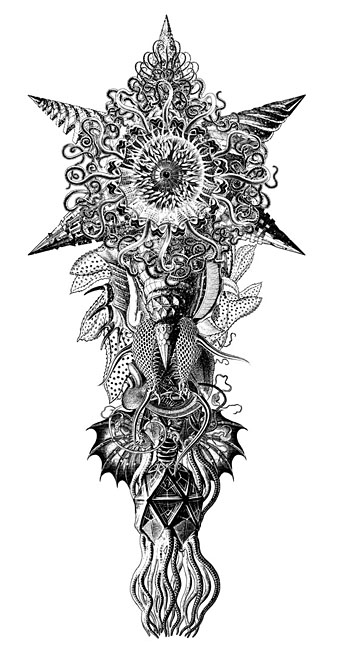
Graphic for the title page and ends of chapters.
I don’t usually post things so far away from publication, but editor Ellen Datlow put these pictures on her Facebook page a few hours ago so I may as well do the same here.
Back in February I bought a Wacom Intuos drawing tablet, something I’ve been using with regularity for the past few months. The Alas Vegas Tarot cards I designed in the summer were the first major attempt at getting used to working with it; Lovecraft’s Monsters, a forthcoming fiction anthology for Tachyon is the second, and I now feel very comfortable working with it. More than that, I’m increasingly pleased with the way it’s possible to combine the drawing techniques I’ve been using for years with the additional possibilities provided by working in Photoshop. As always, it’s the end result that counts but arriving at an end result can be easy or difficult. Some of these illustrations look no different than they would have done had I used ink on paper but they took half the time to create, a considerable benefit when a deadline is looming.
The stories Ellen Datlow has chosen for this collection all present different aspects of monstrosity seen through the lens of Lovecraft’s fiction and his cosmic menagerie. Some are full-on extensions of the Mythos, others are more allusive; all the pieces bar one have been published before but I’d not read any of them so for me this was fresh material. Having spent the past few years saying I was finished with Lovecraft’s fiction I was excited to be working on this book. The stories are good, and I welcomed the challenge of having to illustrate such a variety of material.
Larger copies of all the pictures can be seen here.
The star-headed thing at the top of this page is another amalgam of elements plundered from Haeckel’s Kunstformen der Natur and other sources. I’ve leaned rather heavily on Haeckel in the past, something I wanted to avoid here; this serves as a kind of visual punctuation separating the stories.
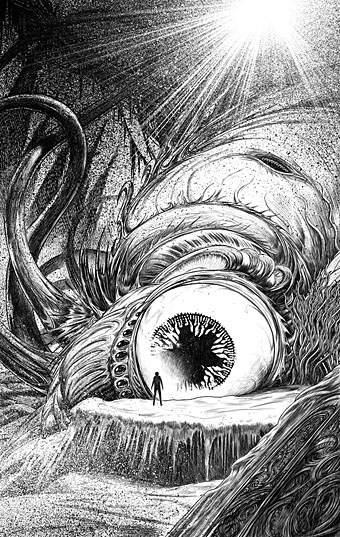
Cthulhu.
The drawing I’ve called Cthulhu is a piece for the introductory pages. Having already produced a lot of Cthulhoid art I didn’t want to repeat myself. The initial idea was of a tiny human figure faced with something enormous and nightmarish; that could be a vast eyeball or it could be a mouth or some other organ/aperture, the vagueness was intentional. Lovecraft continually impresses upon his readers how difficult things are to describe or apprehend but you seldom find this quality in art based upon his stories. Cthulhu especially has devolved into little more than an outsize man-in-a-rubber-suit à la the Creature from the Black Lagoon. In The Call of Cthulhu the figure on the mysterious statuette is described as having a humanoid shape but Lovecraft doesn’t describe the appalling reality in any detail at all. When Cthulhu is struck by a ship at the end of the story it breaks apart and is then seen recombining, the implication being that the creature is corporeally amorphous.
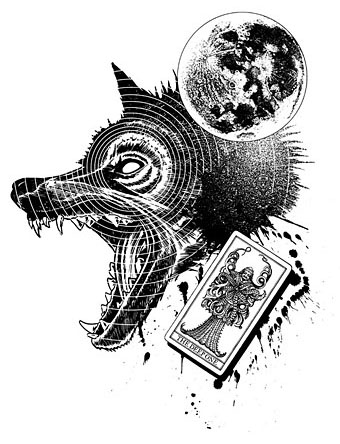
Only the End of the World Again by Neil Gaiman.
Neil Gaiman’s entry concerns a werewolf private detective in Innsmouth. Lovecraft’s decaying fishing village and its inhabitants turn up in several of the stories so care was taken to avoid repetition.
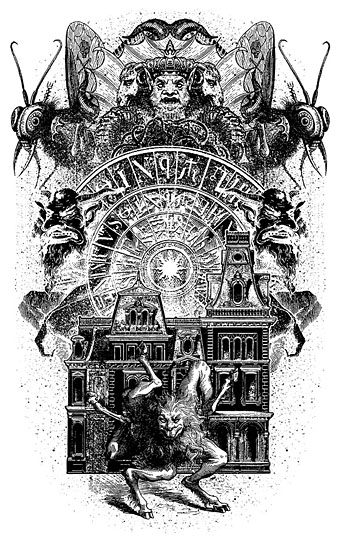
Bulldozer by Laird Barron.
A great story about another detective, a Pinkerton agent this time, hunting his quarry through the Old West. Collin de Plancy’s Dictionnaire Infernal is mentioned so I used some of Louis Breton’s illustrations from the third edition.
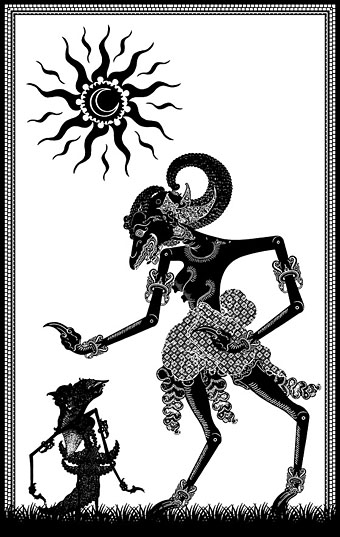
Red Goat Black Goat by Nadia Bulkin.
Shub-Niggurath in West Java, hence the Javanese shadow puppets.
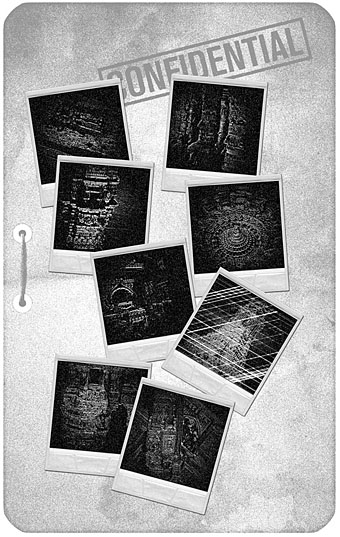
The Same Deep Waters as You by Brian Hodge.
At the end of The Shadow over Innsmouth the inhabitants of the town are interned by the authorities. Brian Hodge’s story has them still locked away in the present day, a state of affairs explicitly compared to the Guantanamo prisoners.
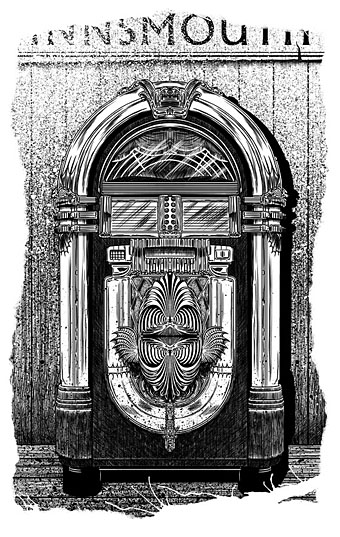
A Quarter to Three by Kim Newman.
Innsmouth again, and a very short piece with a jukebox playlist as its focus.
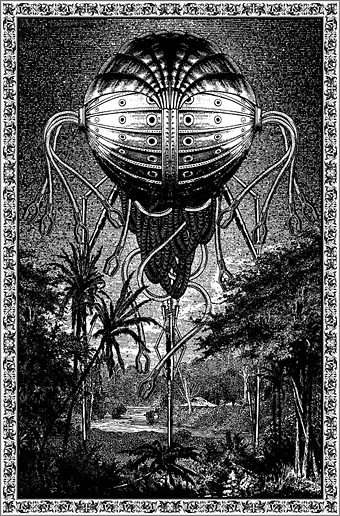
The Dappled Thing by William Browning Spencer.
This one is an alternate history/steampunk affair so I resorted to the engraving-collage style I tend to use for steampunk material.
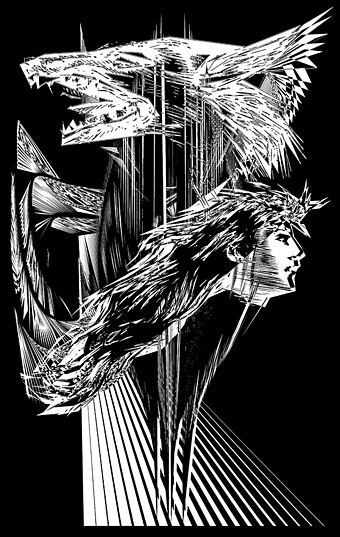
Inelastic Collisions by Elizabeth Bear.
Two Hounds of Tindalos here manifest as a pair of human sisters one of whom is very irritated by her new body and the strains of pretending to be human. The Hounds exist in an angled, curveless dimension so I processed the artwork to turn all the curves into lines and angles.
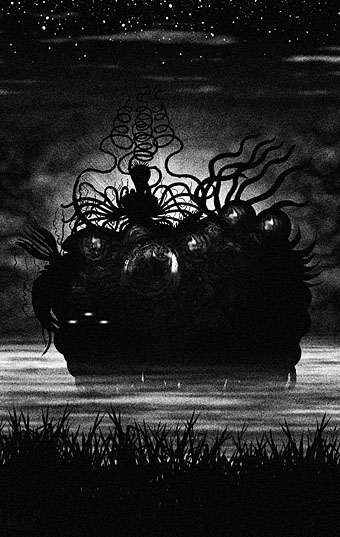
Remnants by Fred Chappell.
A small family group are among the Earth’s last remaining human survivors after the Old Ones have commandeered the planet, their lives reduced to scrabbling for food and hiding from roaming shoggoths. The consequences of this kind of apocalypse are often implied (Wilbur Whateley talks about “clearing off the Earth”) but seldom spelled out in any detail. Chappell’s story is essentially science fiction but with a bleak edge of horror: the Moon has already been refashioned for some fathomless purpose; the Earth is next.
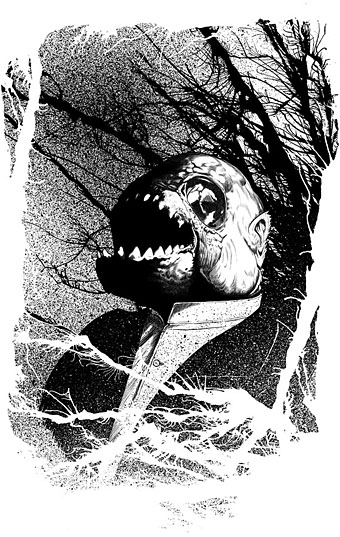
Love is Forbidden, We Croak and Howl by Caitlín R. Kiernan.
Innsmouth and the Deep Ones again, as if this could be anything else.
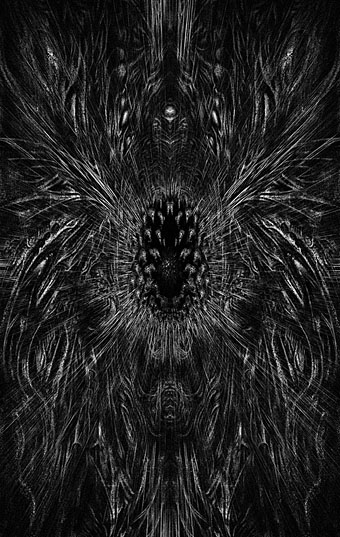
The Sect of the Idiot by Thomas Ligotti.
An early piece from Ligotti, and the one that’s most redolent of Lovecraft’s writing style. A quote at the beginning mentions Azathoth so that’s what I’ve depicted.
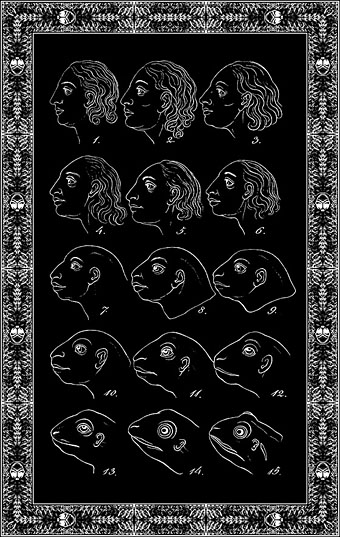
Jar of Salts by Gemma Files.
A poem by Gemma Files. This was a cheat on my part since the heads are from Johann Kaspar Lavater’s Physiognomische Fragmente zur Beförderung der Menschenkenntnis und Menschenliebe (1775–1778), a multi-volume study of physiognomy which frequently compares human heads to their supposed animal counterparts. This fits so well with the inhabitants of Innsmouth it was irresistible.
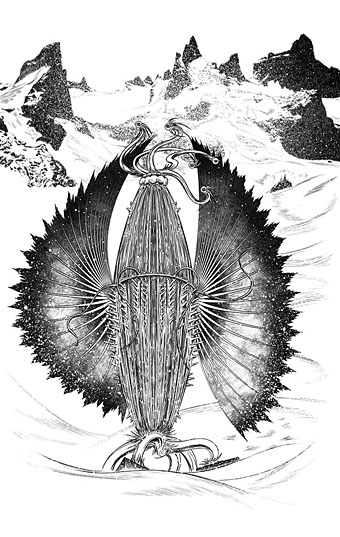
Black is the Pit From Pole to Pole by Howard Waldrop and Steven Utley.
A miniature epic which manages to combine Mary Shelley’s Frankenstein (which ends at the North Pole) with a variety of Antarctica narratives including At the Mountains of Madness (of course), hence the Elder Thing.
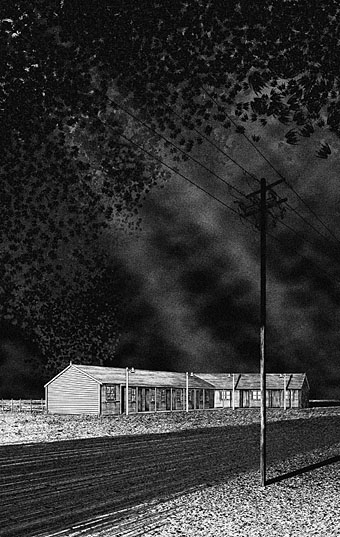
Waiting at the Cross Roads by Steve Rasnic Tem.
Many of these illustrations are flat or front-on; this story concerns events at a desert motel for which I wanted a very accurate perspective. The light is meant to be that bright illumination and very low cloud you get before or after thunderstorms.
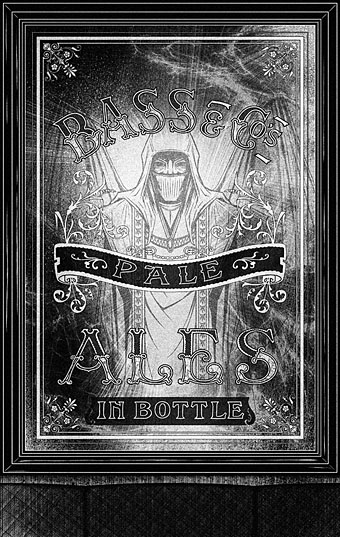
I’ve Come to Talk with You Again by Karl Edward Wagner.
Robert Chambers’ King in Yellow in a London pub. Although Lovecraft only mentions the King in Yellow in his appraisal of Chambers’ stories in the supernatural fiction essay, there is a similar masked figure ruling over the dread plateau of Leng in the Dreamlands. Lovecraft also mentions Hali (a name which Chambers took from Ambrose Bierce) and The Yellow Sign in The Whisperer in Darkness.
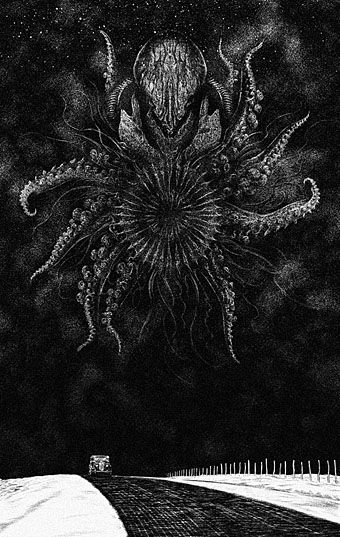
The Bleeding Shadow by Joe R. Lansdale.
The old Robert-Johnson-meets-the-Devil riff is given a Lovecraftian twist. A typically feisty Lansdale story.
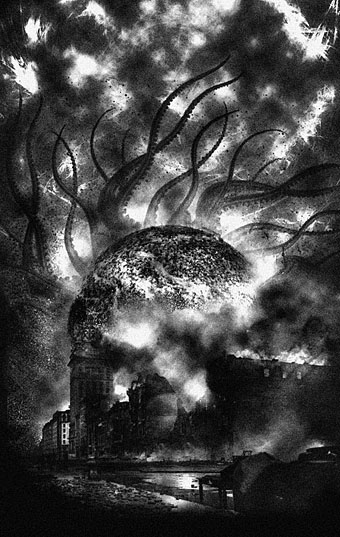
That of Which We Speak When We Speak of the Unspeakable by Nick Mamatas.
Another short piece, this is a semi-photo collage showing a destructive manifestation in an American city.
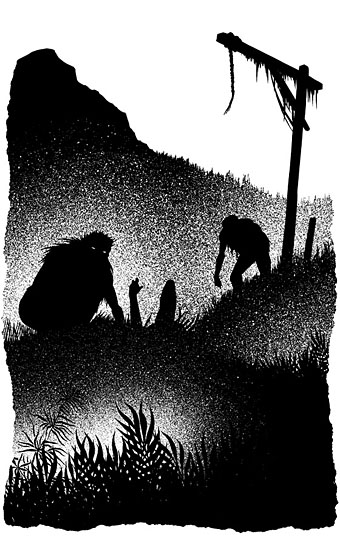
Haruspicy by Gemma Files.
Another poem, the subject this time being Ghouls.
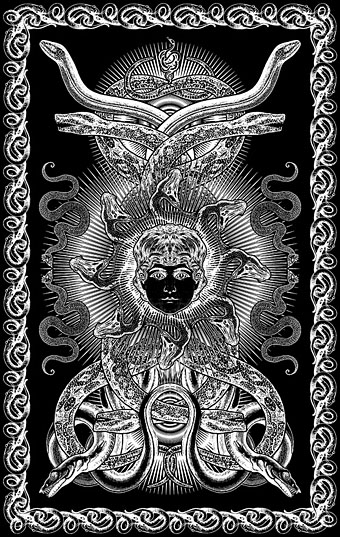
Children of the Fang by John Langan.
Serpent gods, serpent people.
Elsewhere on { feuilleton }
• The Lovecraft archive

i just typed in one of the story names and arrived here, thank you for the art. I see you just put these up, love them all
Its a shame that Michael Cisco hasn’t had you cook anything else up for his stories. There are a few stories in the Secret Hours that remind me so much of your graphic novel works for their elusive marriage of ethereal and visceral. Yes, an ethereally visceral or viscerally ethereal collaboration between Terry Gilliam and reincarnated ancient Aztec and Mayan scribes is how I would describe your artwork. Ideal for such a challenging author.
Another story your pictures bring to mind, the exact name eludes me, is one of Clark Ashton Smith’s martian tales involving an enormous pit accessed via an interior stairwell spanning its circumference carved in prehistory, wherein dwells a mute cabal of eyeless humanoids who worship a statue that is really a powerful hibernating being that reanimates to blind intruders and add them to its harem of worshippers. A very eerie, intense, and eloquent story, one of my favorites of his. Goddamn, what was its title.
Regardless of comparison, excellent work as always. I’ve always been rather picky when it comes to literature. I remember a post regarding the so-called Old and New-Weird. While I certainly agree that the inclinations amidst much of the Old-Weird toward rather poorly veiled misogyny, anti-semitism, and pro-Western politics, could be at best viewed as distracting, and at worst as downright exhausting. Yet, not all of them fall so definitely into this category. Smith and Hodgson were probably my favorites, and their work is relatively free of this.
On the other hand much of the New-Weird- Ligotti, Vandermeer, and Cisco all being strong exceptions, seems very derivative and recycled, afraid of taking risks, disguising their lack of momentum as subtlety and/or experimentalism when neither really seems present.
No, I am generally very cautious regarding the new weird as well, but I am not familiar with half of the authors you’ve mentioned. Add to this your artwork, and I guess I’ll probably have to pick this up whenever it comes out.
On a side note, I’ve always loved much of the metaphysically-themed artwork that comes from Indonesia, so I am rather glad to see someone of taste using those Javanese puppets for something of this nature. Have you ever heard of a man named I Ketut Budiana? He’s a Balinese painter, not rich or upper class at all, just an older man making artwork for festivals and local temples. Yet, his massive paintings are, in my opinion, much better than those of most of the famous symbolists and surrealists. They also play about with perspective, physics, and scale in a manner that also reminds me of your work, albeit in strictly traditional mediums.
I’m proofreading LM now and I think the illos. work really well with the tales. Especially like the one that accompanies Kiernan’s story. Great stuff!
(And thanks for the kind words a while ago about my own collages on 50 Watts!).
Wiley: I’m not always so keen to try and illustrate more subtle fictions like Cisco’s since they work their effects inside the gap that forms between the words and the reader’s imagination. My book agent a while ago asked if I’d be interested in adapting a Robert Aickman story into comics form (she controls Aickman’s estate), but I turned that down for the same reasons (also because I no longer draw comics). Not saying this applies to everything but I try to be cautious about spoiling a story with an illustration it doesn’t require. MR James has been illustrated on several occasions but he’s one writer whose work should really be left alone. Lovecraft and co–especially Clark Ashton Smith–are better because their work has a lot more visual definition even if things aren’t always described so closely.
I’ve got a lot of time for the Old Weird, of course, but they also had it easy in the sense that there was considerable freedom to do what they wanted. Genres weren’t defined the way they are today which is why HG Wells, Lovecraft, Smith, Hodgson, Leiber and many others ranged through sf, horror and fantasy without worrying that they were in the wrong area. During the 1950s science fiction started regarding itself as the leading genre–serious, square-jawed guys writing about technology! the future!–with a growing attitude that fantasy was for girls [sic] while horror was probably for reprobates or the semi-literate. This hierarchy prevails in a diluted form today, horror is the genre that gets pushed to the back all the time like an embarrassing relative. There’s also the commercial problem: genres now are rigid marketing categories, and the most successful writers tend to be those that plough a furrow down the centre of one genre alone. Is At the Mountains of Madness horror, fantasy or science fiction? Lovecraft had to sell it to an sf mag but it blends elements of all three even though it’s sold exclusively today as a horror story.
Not heard of I Ketut Budiana. The shadow puppets was an irresistible idea given the setting. I only noticed after I’d finished the drawing that shadow puppets are mention at the end of the story, a reference I missed. I’ve always liked gamelan music so it was interesting researching another part of the culture. I didn’t know before that the puppets have traditional forms and characters.
Allan: Thanks! Caitlín and I have some other work in a huge Lovecraft anthology due from Centipede Press in March. It’s going to be a Spring of unspeakable monstrosities.
Outstanding.